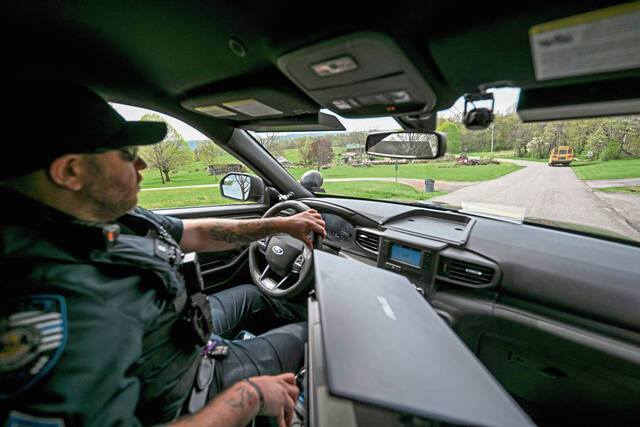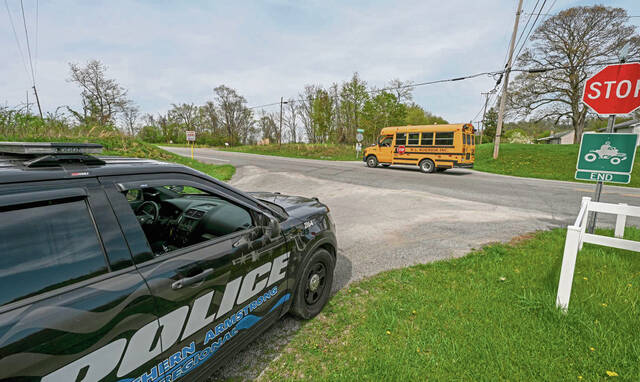Do not pass: Police crack down on school bus scofflaws in Freeport, Leechburg districts
Jennifer Pirhalla grinds her teeth with worry every time she accompanies her two children to their bus stop in rural Gilpin .
Pirhalla is concerned about student safety after witnessing numerous motorists disregarding the lighted stop sign arm on the school bus that picks them up along Johnetta Road.
“I would hate to see one of them get run over due to people being neglectful. I’m sure our bus stop isn’t the only one. These kids and parents need to feel safe getting on and off the bus,” Pirhalla said. “In the last two months, two vehicles have ran a school bus sign without a care in the world.”
Pirhalla reported traffic violations she witnessed to police. As a result, Chris Fabec, chief of the Southern Armstrong Regional Police Department, added a new shift in February for officers in an effort to curtail school bus-related traffic violations.
“It’s something I implemented because we want to make sure everyone is safe,” Fabec said. “We’ve really stepped things up.”
To date, Southern Armstrong Regional officers have issued six bus-related safety citations — five in Gilpin and one in Freeport.
Fabec said the safety issue has become progressively more concerning since last May.
The two roads receiving the most complaints are Route 66 and Schenley Road.
“This year, it started back up again, and the problem is mostly seen on afternoon bus routes with cars coming out of Schenley’s industrial park,” Fabec said. “Everyone says they’re in a hurry or late for work (if pulled over by police), but the message to motorists is one of zero tolerance.”
On school days, a police cruiser will be assigned to escort one of the buses, driving behind it the entire route from 7 to 9 a.m. and during the afternoon route in the communities served by the department: Freeport, Gilpin and Ford City.
Fabec said the added police presence on bus routes appears to be working.
Leechburg Area School District Superintendent Tiffany Nix said Tuesday she was unaware that Southern Armstrong Regional had implemented the procedure, but she welcomed the news.
“I commend them for their intervention and diligence in school bus safety,” Nix said. “I think it’s fantastic, and I very much appreciate it.”
Gilpin resident Steven Berger decided to take bus stop safety patrol matters into his own hands at the stop used by his children at Myers Acre and Schenley roads.
Berger, a truck driver, often dons his own fluorescent safety vest and serves as an unofficial crossing guard to make sure students board and unload from the bus without incident.
“I would rather get hit instead of one of the kids,” Berger said. “The kids know to look both ways before crossing the street, but they’re just kids.”
Berger and his wife always make sure an adult is at the bus stop because of their concerns about student safety.
“My wife witnessed an incident when a truck wasn’t going to stop for the bus, so she walked out into the road and the truck almost hit her,” Berger said. “I see people flying, and they’re trying to beat the bus before it stops.”
The speed limit on Route 66 and Schenley Road is 55 mph.
Under Pennsylvania law, a motorist must stop at least 10 feet away from a school bus with red signal lights flashing and stop arm extended.
A motorist must not proceed until the red lights have stopped flashing, the stop arm is withdrawn and all children have reached a place of safety.
Drivers separated by a physical barrier — such as a median or guardrail — from a school bus dropping off or picking up students do not have to stop.
According to data from the Pennsylvania Department of Transportation, about 17,000 children visit emergency rooms annually because of school bus-related accidents.
An average of 19 children die in school-related traffic accidents each year, with peak accident times occurring from 3 to 4 p.m.
Berger and Pirhalla praised the response and concern shown by police.
“The police presence there — that’s good,” Berger said. “The police have seen things, and they’ve gone after people. I think it’s a good thing they’re acknowledging it’s a problem.”
Berger would like to see more done at the problem-area bus stops.
“The police have been responsive,” Berger said. “(But) I don’t think just a sign will do it. They don’t pay attention to the signs. It would be good to have a sign with a blinking light at the bus stop.”
Joyce Hanz is a native of Charleston, S.C. and is a features reporter covering the Pittsburgh region. She majored in media arts and graduated from the University of South Carolina. She can be reached at jhanz@triblive.com
Remove the ads from your TribLIVE reading experience but still support the journalists who create the content with TribLIVE Ad-Free.




